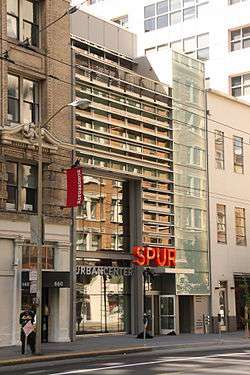San Francisco Bay Area Planning and Urban Research Association

SPUR, formally known as the San Francisco Bay Area Planning and Urban Research Association, is a non-profit research, education, and advocacy organization focused on issues of planning and governance in San Francisco, San Jose and Oakland.
SPUR's history dates back to 1910, when a group of young city leaders came together to improve the quality of housing after the 1906 San Francisco earthquake and fire. That group, the San Francisco Housing Association, authored a hard-hitting report which led to the State Tenement House Act of 1911.
In the 1930s, SFHA continued to advocate for housing concerns. In the 1940s, SFHA merged with Telesis, a group of graduates from UC Berkeley's city planning program, to become the San Francisco Planning and Housing Association. In 1942, the association landed a major success with the creation of San Francisco's Department of City Planning.
During the 1950s, SFPHA pushed for the revitalization of San Francisco as the Bay Area's central city, in an effort to curb suburban sprawl and channel growth back into the urban core. In 1959, the San Francisco Planning and Housing Association was reorganized into the San Francisco Planning and Urban Renewal Association and, in 1977, the San Francisco Planning and Urban Research Association.[1] The group has helped shape some of the most important planning decisions in the region, from the founding of the Bay Area Rapid Transit system (BART) to the preservation of the Golden Gate National Recreation Area.
Over the years, the organization has grown to more than 6,000 members and has diversified its focus, analyzing subjects from sea-level rise and renewable energy to bicycle lanes and the ties between the Beat movement and the cultural understanding of urbanism. SPUR also provides annual analysis and selective endorsement of San Francisco ballot measures.
In June 2009, SPUR moved into new headquarters at 654 Mission Street. This location houses the majority of SPUR's staff, as well as a gallery, a research library, and meeting space for SPUR's regular hosted talks.[2]
In 2012, SPUR initiated a long-range plan to work in all three of the Bay Area's central cities.[3] The organization opened offices in San Jose in 2012[4] and Oakland in 2015,[5] adding "Bay Area" to its name to reflect its broader scope. SPUR's board and staff have developed this strategic plan based on the following assumptions:
- San Francisco's share of jobs and population is declining, most of the growth in the Bay Area is occurring in other areas.
- Most regional decisions are made by local governments.
- SPUR's core competency is urban planning.
- San Jose, Oakland and San Francisco combined represent 30 percent of the region's population and 34 percent of the region's jobs.[3]
References
- ↑ "Our Mission and History". SPUR. Retrieved 2016-02-06.
- ↑ "SPUR moves into new Urban Center". SF Gate. May 24, 2009.
- 1 2 "Announcing the Launch of SPUR San Jose". SPUR. January 12, 2012.
- ↑ "SPUR part of San Jose's formula to develop regional growth". Silicon Valley Business Journal. April 27, 2012.
- ↑ "SPUR to open Oakland office to push 'inclusive growth' policies". San Francisco Business Times. October 6, 2014.
External links
Coordinates: 37°47′14″N 122°24′04″W / 37.78716°N 122.40120°W